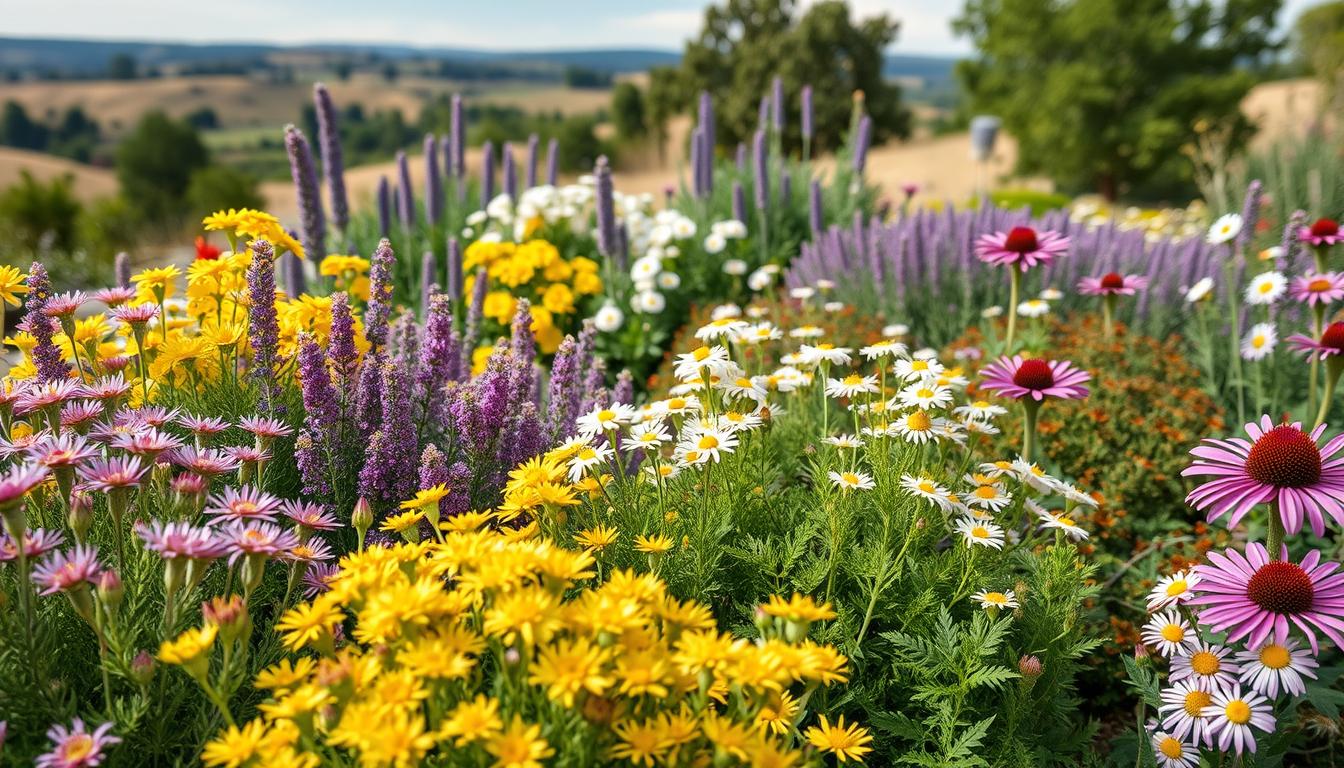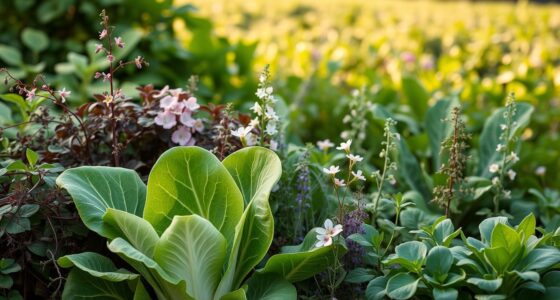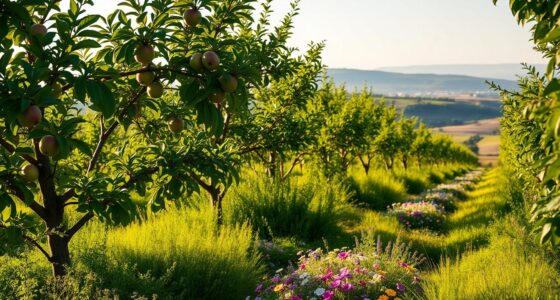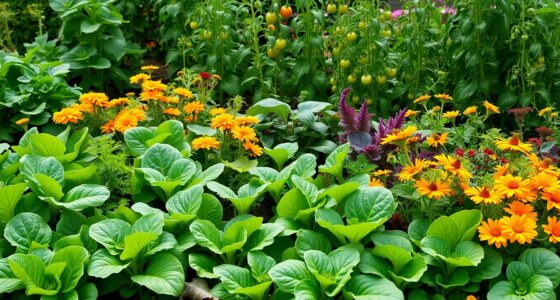Imagine stepping into your garden, where vibrant colors greet you, and the air is filled with the sweet scent of blooming flowers. This serene space connects you to nature in a way that nothing else can. Among the many plants you nurture, yarrow stands out not only for its striking beauty but for its incredible benefits as a companion plant. Yarrow, known scientifically as Achillea millefolium, thrives in various conditions and has a special role in creating a flourishing ecosystem. Discovering the best plants to grow with yarrow can enhance your garden’s health, attract helpful insects, and repel harmful pests. Let’s embark on this journey to explore the wonderful world of yarrow companion plants and elevate your gardening experience.
Key Takeaways
- Yarrow thrives in diverse growing conditions and is an excellent choice for companion planting.
- Companion plants can enhance yarrow’s health and vitality.
- Growing yarrow alongside specific plants attracts beneficial insects.
- Yarrow helps repel common garden pests, creating a healthier garden ecosystem.
- Understanding the best plants to grow with yarrow can lead to a more successful gardening experience.
What is Yarrow and Why Grow It?
Yarrow, scientifically known as Achillea millefolium, is a hardy perennial that thrives in various climates, making it an excellent addition to any garden. This resilient plant flourishes in USDA zones 3-9 and showcases beautiful clusters of small flowers in colors such as white, yellow, red, and pink from spring through fall. The numerous yarrow gardening benefits make it a worthwhile choice for both novice and seasoned gardeners alike.
Benefits of Yarrow in the Garden
Growing yarrow can enhance your garden in several ways:
- Pollinator Attraction: Yarrow attracts beneficial insects like bees and butterflies, essential for plant reproduction.
- Low Maintenance: Its ability to thrive in poor soils and tolerate drought makes yarrow a low-maintenance option for your outdoor space.
- Natural Pest Control: Yarrow has natural properties that help repel unwanted garden pests.
- Soil Improvement: This plant can contribute to soil health by improving its structure and nutrient content.
How to Identify Yarrow
Identifying yarrow plants is relatively straightforward. Look for:
- Feather-like Leaves: The distinctive foliage resembles ferns, making the plant easy to recognize.
- Flat-topped Flower Clusters: The flowers form clusters at the top of long stems, creating a flat-topped appearance.
- Height: Yarrow typically stands between 2 to 3 feet tall, adding height to your garden.

Ideal Conditions for Yarrow Growth
To successfully cultivate yarrow, paying attention to its ideal growth conditions is essential. This resilient plant requires specific conditions to thrive and yield the best results in your garden.
Soil Requirements
Yarrow flourishes in well-drained, slightly alkaline soil, making soil for yarrow a crucial factor for successful growth. Aim for a pH between 6.0 and 8.0 for optimal results. A loose, sandy loam or a gravelly mix can ensure adequate drainage while supporting healthy root development. Amendments such as lime can help achieve the desired alkalinity, promoting an ideal environment for yarrow.
Sunlight Needs
Full sun is vital for yarrow, as it requires at least six hours of direct sunlight each day. These yarrow growth conditions not only enhance its growth but also boost the plant’s vibrant flowers, making them an attractive addition to your garden. Position yarrow in an area that receives ample sunlight to ensure healthy foliage and flourishing blooms.
Watering Practices
Once established, yarrow exhibits remarkable drought tolerance. Deep watering at planting time is important to encourage root establishment. Following this, maintain moderate watering to promote healthy growth while avoiding over-saturation. Implementing a layer of mulch can help retain moisture and suppress weeds, further benefiting yarrow’s growth conditions. Consistent care will lead to a thriving yarrow plant that enhances your garden.
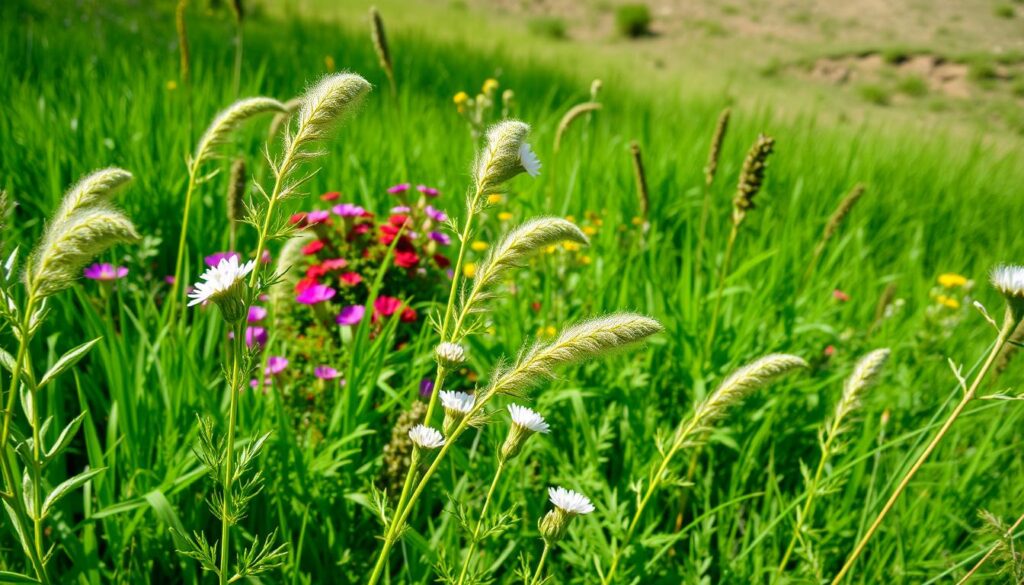
Effective Yarrow Companion Plants
Companion planting with yarrow offers various benefits, including pest control and enhanced pollinator attraction. Effective yarrow companions share similar growth conditions, making them suitable for your garden. When pairing yarrow with good companion plants, consider those that thrive in full sun and require minimal watering.
What Makes a Good Companion Plant?
A good companion plant complements yarrow by attracting beneficial insects and repelling harmful pests. Ideal partners often have similar watering and sunlight needs, creating an efficient and harmonious garden ecosystem. The right combinations can promote biodiversity and improve overall plant health.
Top Companion Plants for Yarrow
- Bee Balm: This herb not only attracts bees but also promotes a vibrant garden atmosphere.
- Salvia: Known for its beautiful blooms and drought resistance, salvia thrives alongside yarrow.
- Rosemary: This fragrant herb is drought-tolerant and can deter pests.
- Coneflowers: These bright flowers provide seasonal color and attract pollinators.
- Hydrangeas: With varying bloom colors, hydrangeas can visually enhance your garden space.

Culinary Companion Plants for Yarrow
When you decide to incorporate culinary plants with yarrow in your garden, chives and basil stand out as remarkable choices. These plants not only enhance the flavor of your meals but also support the overall health of your garden ecosystem.
Chives: Flavor and Pests Control
Chives companion planting with yarrow serves multiple purposes. This herb offers a mild onion flavor, elevating countless dishes. Beyond taste, chives act as a natural pest deterrent. They help repel aphids, which can be detrimental to yarrow. Including chives in your garden promotes not only flavor diversity but also healthier plants.
Basil: Flavor Boost and Benefits
Basil is another excellent partner for yarrow in any garden. This herb amplifies the overall culinary experience with its aromatic profile. Basil attracts beneficial insects, which assist in pollination and pest control. As you maintain your garden, consider how these culinary plants with yarrow interact, creating a vibrant and productive backyard oasis.
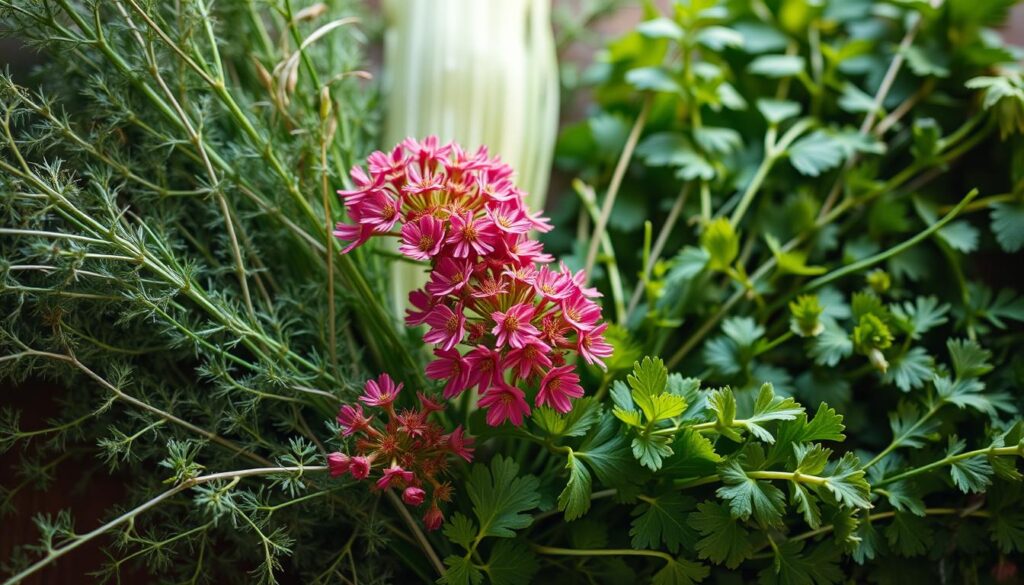
| Plant | Flavor Profile | Pest Control | Companion Benefits |
|---|---|---|---|
| Chives | Mild onion | Repels aphids | Enhances flavor; promotes yarrow health |
| Basil | Aromatic | Attracts beneficial insects | Boosts flavor; improves pollination |
Pollinator-Friendly Companion Plants
Creating a vibrant garden benefits from the inclusion of pollinator-friendly yarrow companions. These plants can enhance not only your garden’s beauty but also its ecological health. Incorporating yarrow with certain companions will help attract bees with yarrow and other beneficial insects, promoting a thriving local ecosystem.
Lavender: Attracting Bees and Butterflies
Lavender brings not only delightful fragrance but also serves as a haven for bees and butterflies. Its purple blooms are irresistible to pollinators, making it an ideal partner for yarrow. Together, these plants create a striking visual contrast while ensuring a continuous supply of nectar throughout the growing season.
Echinacea: Supporting Local Pollinators
Echinacea, or coneflower, complements yarrow remarkably well. This sturdy perennial shares similar growing conditions and flowers in succession with yarrow. By choosing Echinacea, you can enhance the biodiversity of your garden while furthering your commitment to supporting local pollinator populations.
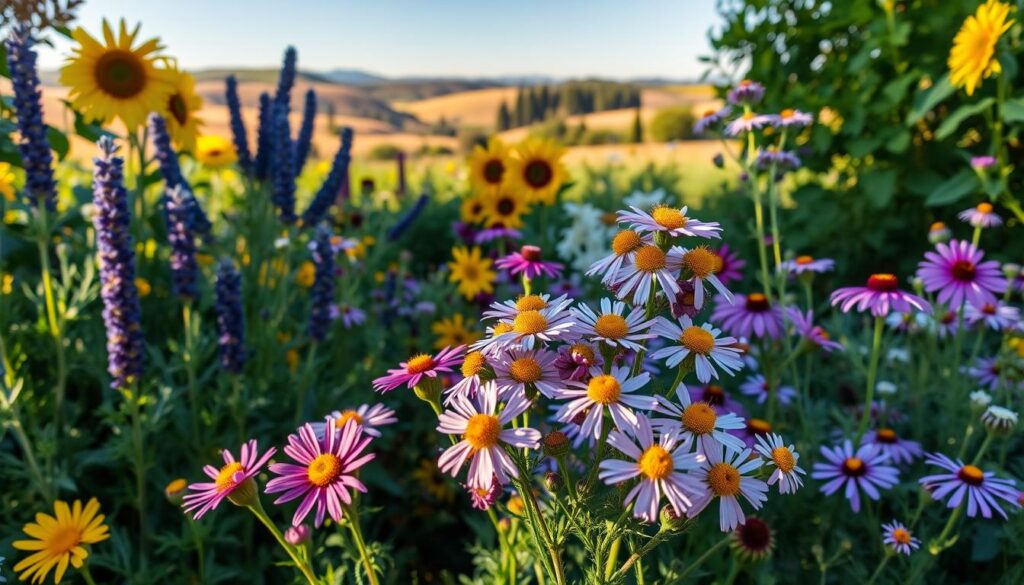
Medicinal Companion Plants
Integrating medicinal plants with yarrow can enhance both the beauty and functionality of your garden. This section highlights two exceptional companions: calendula and mint, which provide numerous health benefits while growing harmoniously alongside yarrow.
Calendula: Healing Properties and Uses
Calendula, known for its vibrant yellow and orange blooms, is revered for its healing properties. It supports wound healing, reduces inflammation, and has antiseptic qualities. Planting calendula and yarrow together creates a dynamic duo in your garden. Both plants not only thrive well in similar conditions but also attract beneficial insects that contribute to a healthy ecosystem.
Mint: Aromatic Benefits and Growth
Mint offers a refreshing aroma and serves as a natural pest repellent. Growing mint alongside yarrow not only utilizes space efficiently but also enhances your garden’s fragrance. The combination of medicinal plants with yarrow, such as mint and calendula, can uplift the atmosphere while providing various health benefits. Both plants flourish with proper care and help in creating a lush, vibrant garden.
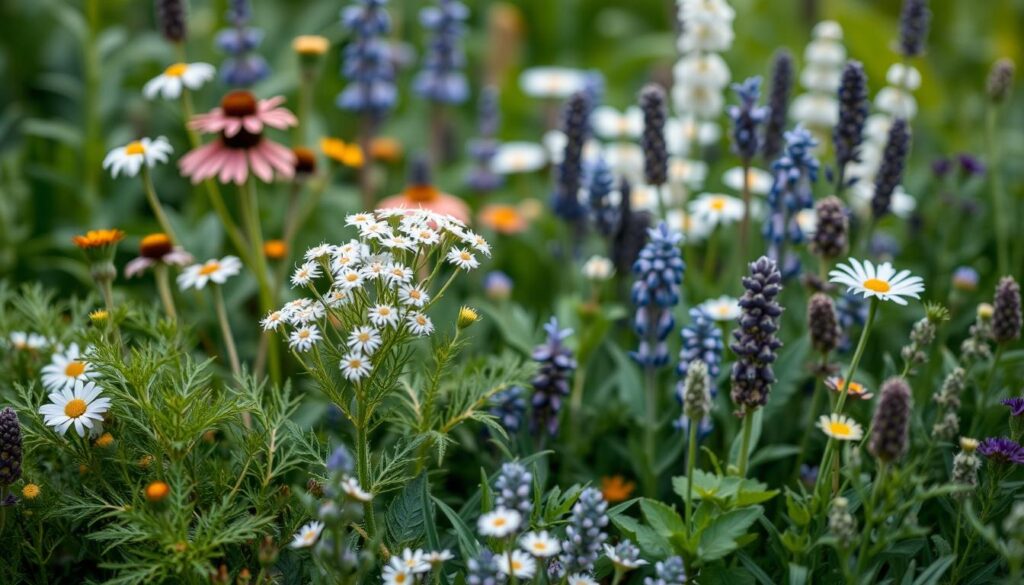
Vegetables that Pair Well with Yarrow
Integrating yarrow into your garden can lead to impressive results, especially when paired with specific vegetables. Many gardeners have discovered that certain vegetable companions for yarrow significantly enhance overall growth and flavor. Notably, yarrow with tomatoes creates a dynamic duo that brings numerous benefits to your garden.
Tomatoes: Enhancing Flavor and Growth
Tomatoes thrive when grown alongside yarrow. This herb’s unique ability to attract beneficial predatory insects helps ward off common tomato pests like hornworms. These insects not only provide protection but can also enhance the overall flavor of your tomatoes. The presence of yarrow encourages a healthy ecosystem, making it an essential companion for anyone looking to cultivate tomatoes.
Carrots: Companion Benefits Explored
Carrots also benefit from being near yarrow. The two plants maximize garden space while supporting each other’s growth. Yarrow promotes healthier carrot development, allowing you to reap a bountiful harvest with ease. The combination of these vegetable companions for yarrow simplifies your gardening tasks, encouraging effective irrigation while fostering a vibrant garden atmosphere.

| Vegetable | Benefits of Pairing with Yarrow | Growth Considerations |
|---|---|---|
| Tomatoes | Protection from pests; enhanced flavor | Grow in well-drained soil with full sun |
| Carrots | Improved growth; maximized space | Requires loose, well-aerated soil |
Herbs to Grow with Yarrow
Planting herbs growing with yarrow can significantly enhance the overall health and productivity of your garden. Yarrow companion herbs, such as oregano and thyme, naturally complement each other, providing mutual benefits. These herbs thrive in similar conditions, allowing for an aesthetically pleasing and functional garden arrangement.
Oregano: Natural Pest Control
Oregano is known for its natural pest control properties, making it an excellent choice to grow alongside yarrow. Both plants require full sun and well-drained soil, simplifying care. Oregano’s aromatic oils deter harmful pests, contributing to a healthier environment for yarrow and other plants. This herb’s vibrant green foliage and delightful scent enhance the garden’s appeal.
Thyme: Flavorful and Resilient
Thyme pairs beautifully with yarrow, offering not only a flavorful addition to meals but also resilience in challenging growing conditions. This herb can withstand drought and poor soil, making it a hardy companion. Thyme’s low growth habit allows it to fit seamlessly into garden beds without overshadowing yarrow. Together, these herbs create a fragrant and thriving garden atmosphere.
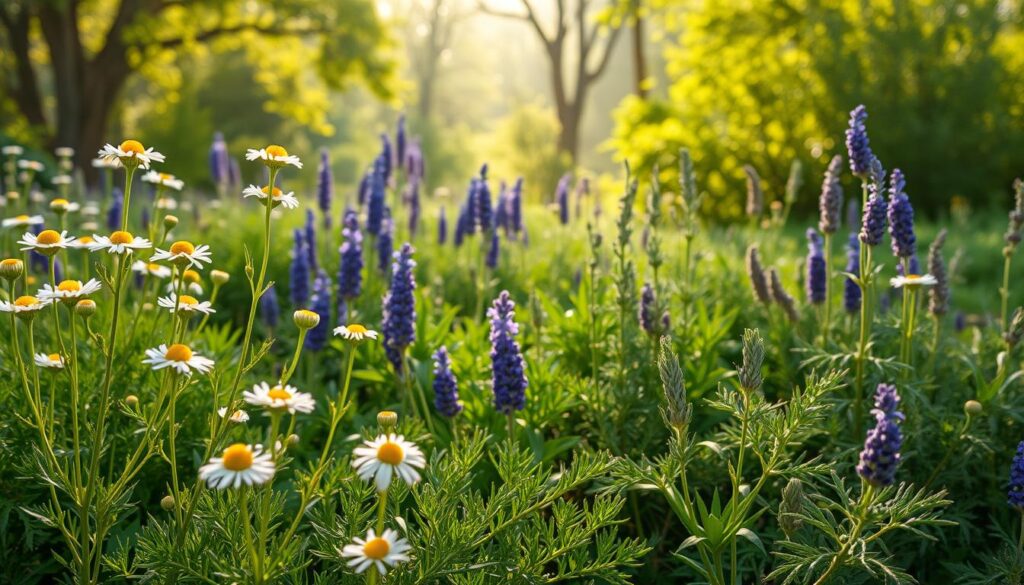
| Herb | Pest Control | Sunlight Needs | Growth Habit |
|---|---|---|---|
| Oregano | High | Full Sun | Upright |
| Thyme | Moderate | Full Sun | Low and Spreading |
Flowers that Complement Yarrow
Incorporating flower companions for yarrow can enhance the aesthetic and ecological balance of your garden. These vibrant blooms not only beautify the landscape but also create a thriving environment for beneficial insects. Two remarkable options that pair well with yarrow are Black-eyed Susans and Coneflowers. Each of these flowers contributes unique benefits to your garden while complementing the vibrant qualities of the yarrow plant.
Black-eyed Susan: Aesthetic Appeal
Black-eyed Susans offer a burst of bright yellow color, creating a striking visual contrast with the delicate blooms of yarrow. These flowers are known for attracting pollinators such as bees and butterflies, which are essential for a healthy garden ecosystem. Besides their aesthetic appeal, Black-eyed Susans can provide essential nutrients to surrounding plants, making them excellent flower companions for yarrow. You will enjoy a lively garden with these lovely additions.
Coneflower: Color and Wildlife Support
Coneflowers, or Echinacea, bloom beautifully alongside yarrow, adding depth with their vibrant purple and pink hues. Their structural form provides support to local wildlife, including beneficial insects crucial for pest control. Coneflowers naturally attract pollinators, enhancing your garden’s biodiversity while working harmoniously with yarrow plant pairs. Growing Coneflowers not only beautifies your garden but also contributes to a more sustainable gardening practice.
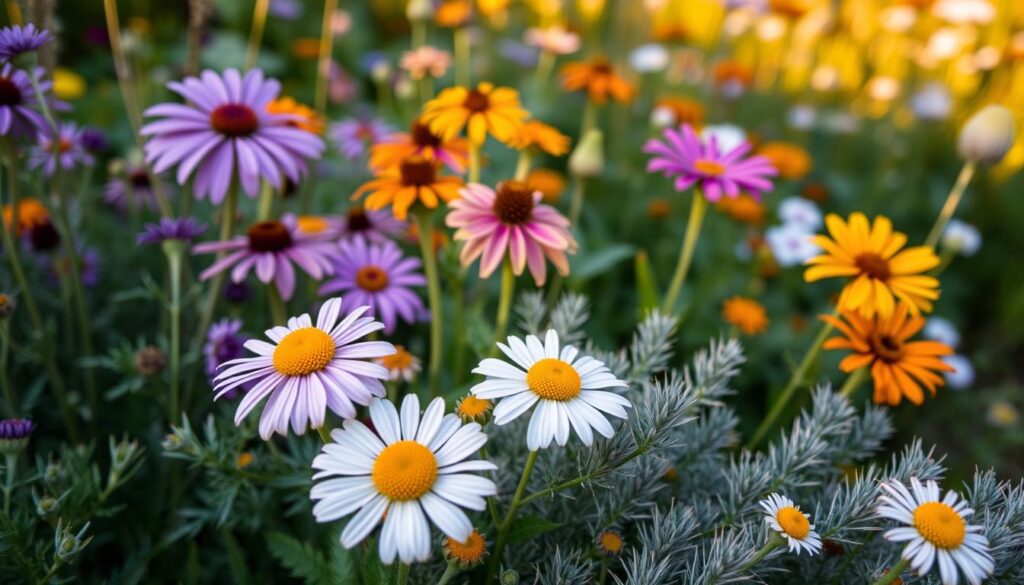
Common Pests and Yarrow’s Role
Yarrow serves as a vital tool in managing pests in your garden. Its presence encourages the attraction of beneficial insects, which play a significant role in controlling the populations of harmful pests. By enhancing biodiversity, yarrow supports a healthier ecosystem in your outdoor space.
How Yarrow Repels Common Garden Pests
Using yarrow in pest management creates a garden environment that is less conducive to pests. Although yarrow itself may not repel every insect, it draws in predators like ladybugs and lacewings. These beneficial insects feast on aphids, mites, and other common nuisances, leading to natural yarrow pest control. By inviting these allies into your garden, yarrow helps maintain a balance, minimizing the need for chemical interventions.
Use of Yarrow in Integrated Pest Management
Yarrow plays a supportive role in integrated pest management strategies. Including this plant in your garden allows for a more holistic approach to pest control, where natural processes are prioritized. By bolstering the presence of beneficial insects, yarrow contributes to a self-sustaining ecosystem. This aligns perfectly with organic gardening methods, promoting your commitment to environmentally friendly practices.
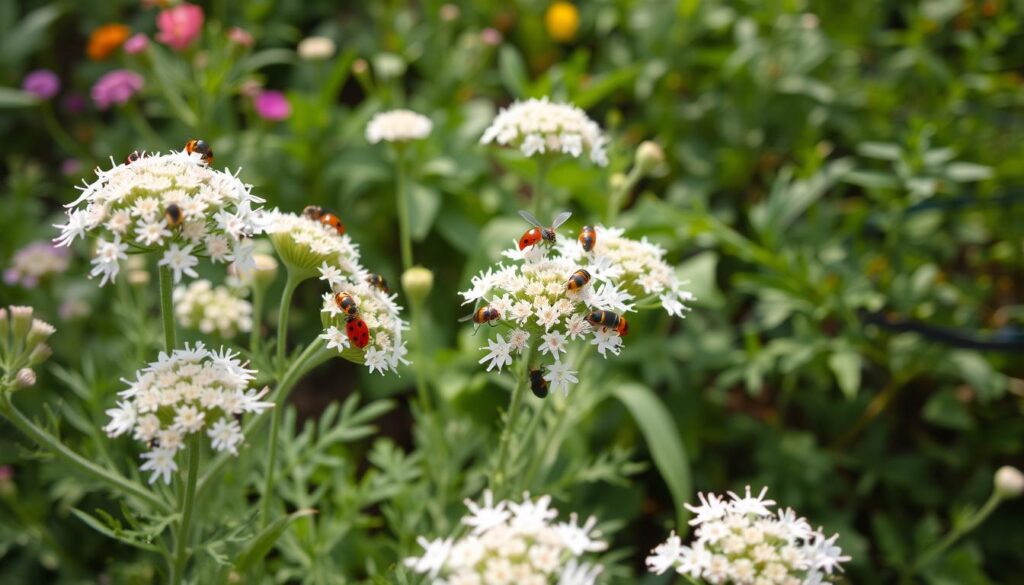
Tips for Planting Yarrow with Companions
Creating harmonious yarrow garden arrangements involves considering spacing and timing. Careful planning ensures that your planting yarrow companions thrive together, enhancing both aesthetics and overall health in your garden.
Spacing and Arrangement Tips
When planting yarrow companions, allow for adequate space. Aim for a spacing of 12 to 24 inches between each plant. This distance enables ample sunlight and airflow, promoting healthy growth. Group companion plants according to their height and color to create a visually appealing display. Shorter plants can be placed in the front, with taller varieties positioned in the back. This arrangement showcases the unique features of each plant while maximizing the use of available space.
Timing: When to Plant Together
Timing plays a crucial role in your planting yarrow companions. The best times to plant yarrow and its companions are in spring or fall. Aligning the planting schedules of all companion plants fosters a cohesive growth cycle. This synchronization enhances compatibility, ultimately leading to a more vibrant and productive garden. Regular observation will allow you to adjust care as needed throughout the growing season.
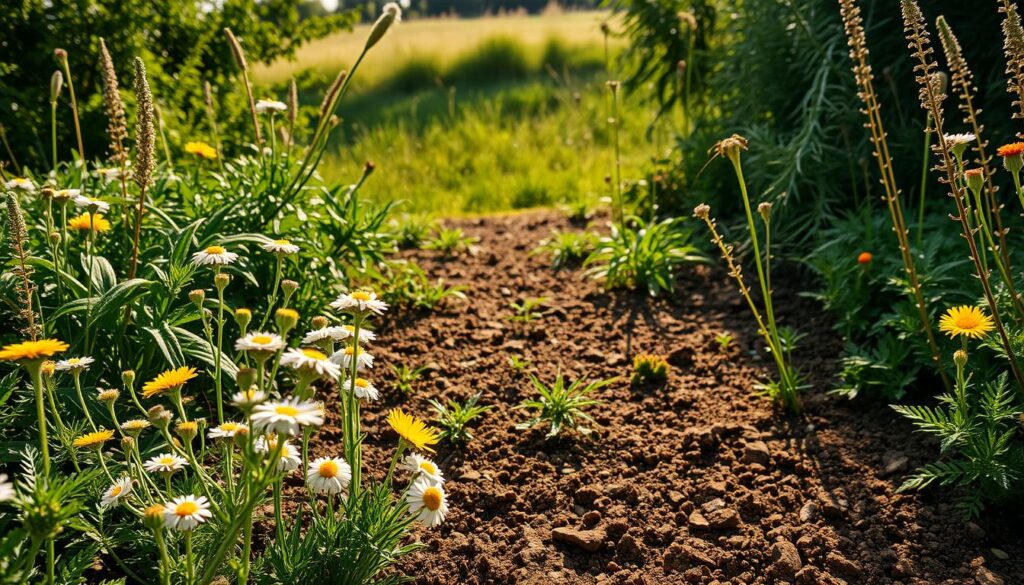
Maintenance for a Thriving Companion Garden
To create an environment where yarrow and its companions can flourish, you must pay attention to several maintenance factors. Implementing simple, regular tasks will ensure healthy growth and vibrant blooms in your garden. Proper maintenance for yarrow garden involves adequate watering, organic fertilization, and timely pruning activities.
Watering and Fertilization Needs
Watering your yarrow and its companions is essential, especially during dry spells. Conduct a thorough check of the soil’s moisture level before applying water. Too much moisture can lead to root rot, so aim for consistent but moderate hydration. During the growing season, organic fertilizers, such as compost or fish emulsion, provide essential nutrients and support vigorous growth. These practices are vital for caring for yarrow companions, ensuring they thrive alongside your yarrow plants.
Deadheading and Pruning Practices
Regular deadheading encourages more blooms, enhancing the overall aesthetic of your garden. Remove spent flowers promptly, which not only improves looks but also redirects energy toward new growth. Pruning yarrow plants effectively prevents legginess and maintains a bushy shape. These straightforward techniques are essential for keeping your maintenance for yarrow garden efficient and enjoyable.

Conclusion: Enhancing Your Garden with Yarrow
Planting yarrow alongside suitable companions not only enhances your garden’s visual appeal but also fosters a healthy ecosystem. The yarrow garden benefits are abundant—it attracts beneficial pollinators like bees and butterflies while repelling common pests that threaten plant health. By integrating yarrow with various companion plants, you can create a vibrant setting that contributes to a flourishing garden.
Recap of Companion Plant Benefits
Incorporating different yarrow companions into your garden can lead to numerous advantages, including improved plant growth and resilience. Each companion plant offers unique contributions that enhance your gardening experience. You’ll notice healthier plants, enhanced flavors, and even increased wildlife activity, making your outdoor space more lively and productive.
Encouragement to Experiment and Enjoy
Don’t hesitate to embrace the journey of experimenting with yarrow companions. Take time to discover the best combinations for your particular garden. Engaging with the process can be incredibly rewarding, providing you with a deeper understanding of your space and its possibilities. Enjoy the exploration, as each new companion plant can lead to delightful surprises in your gardening adventure.
